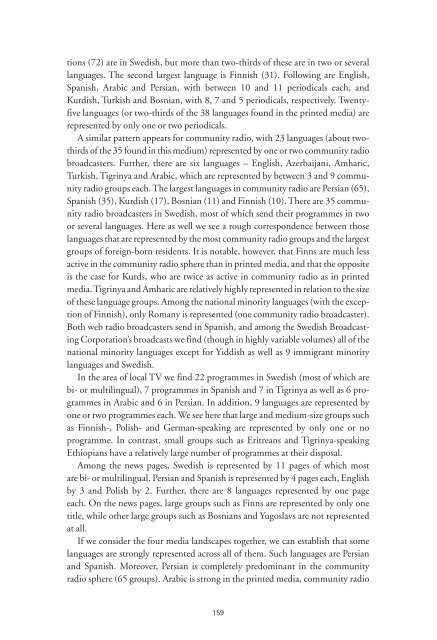Minoritetsmedier och minoritetsmediepolitik i Sverige - Myndigheten ...
Minoritetsmedier och minoritetsmediepolitik i Sverige - Myndigheten ...
Minoritetsmedier och minoritetsmediepolitik i Sverige - Myndigheten ...
You also want an ePaper? Increase the reach of your titles
YUMPU automatically turns print PDFs into web optimized ePapers that Google loves.
tions (72) are in Swedish, but more than two-thirds of these are in two or several<br />
languages. The second largest language is Finnish (31). Following are English,<br />
Spanish, Arabic and Persian, with between 10 and 11 periodicals each, and<br />
Kurdish, Turkish and Bosnian, with 8, 7 and 5 periodicals, respectively. Twentyfive<br />
languages (or two-thirds of the 38 languages found in the printed media) are<br />
represented by only one or two periodicals.<br />
A similar pattern appears for community radio, with 23 languages (about twothirds<br />
of the 35 found in this medium) represented by one or two community radio<br />
broadcasters. Further, there are six languages – English, Azerbaijani, Amharic,<br />
Turkish, Tigrinya and Arabic, which are represented by between 3 and 9 community<br />
radio groups each. The largest languages in community radio are Persian (65),<br />
Spanish (35), Kurdish (17), Bosnian (11) and Finnish (10). There are 35 community<br />
radio broadcasters in Swedish, most of which send their programmes in two<br />
or several languages. Here as well we see a rough correspondence between those<br />
languages that are represented by the most community radio groups and the largest<br />
groups of foreign-born residents. It is notable, however, that Finns are much less<br />
active in the community radio sphere than in printed media, and that the opposite<br />
is the case for Kurds, who are twice as active in community radio as in printed<br />
media. Tigrinya and Amharic are relatively highly represented in relation to the size<br />
of these language groups. Among the national minority languages (with the exception<br />
of Finnish), only Romany is represented (one community radio broadcaster).<br />
Both web radio broadcasters send in Spanish, and among the Swedish Broadcasting<br />
Corporation’s broadcasts we find (though in highly variable volumes) all of the<br />
national minority languages except for Yiddish as well as 9 immigrant minority<br />
languages and Swedish.<br />
In the area of local TV we find 22 programmes in Swedish (most of which are<br />
bi- or multilingual), 7 programmes in Spanish and 7 in Tigrinya as well as 6 programmes<br />
in Arabic and 6 in Persian. In addition, 9 languages are represented by<br />
one or two programmes each. We see here that large and medium-size groups such<br />
as Finnish-, Polish- and German-speaking are represented by only one or no<br />
programme. In contrast, small groups such as Eritreans and Tigrinya-speaking<br />
Ethiopians have a relatively large number of programmes at their disposal.<br />
Among the news pages, Swedish is represented by 11 pages of which most<br />
are bi- or multilingual. Persian and Spanish is represented by 4 pages each, English<br />
by 3 and Polish by 2. Further, there are 8 languages represented by one page<br />
each. On the news pages, large groups such as Finns are represented by only one<br />
title, while other large groups such as Bosnians and Yugoslavs are not represented<br />
at all.<br />
If we consider the four media landscapes together, we can establish that some<br />
languages are strongly represented across all of them. Such languages are Persian<br />
and Spanish. Moreover, Persian is completely predominant in the community<br />
radio sphere (65 groups). Arabic is strong in the printed media, community radio<br />
159

















